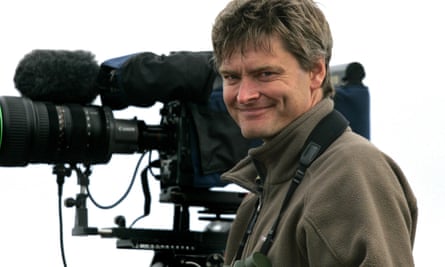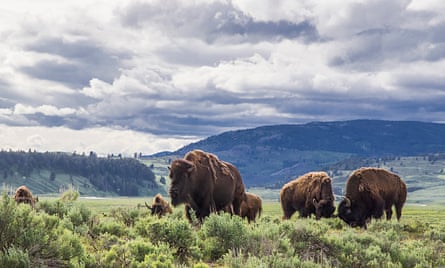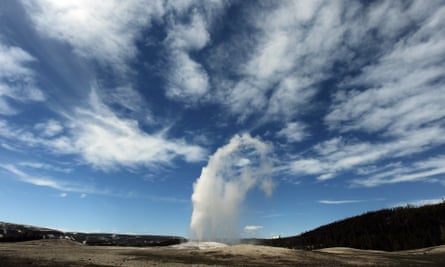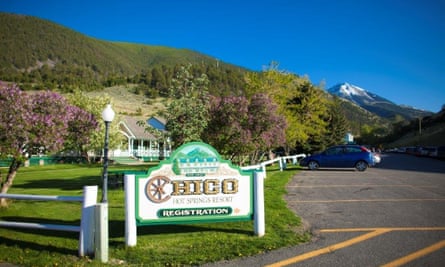I first went to Yellowstone national park, a huge area of wild country in the Rocky Mountains in Wyoming, in the winter of 1992, while learning how to film wildlife with my girlfriend (now wife) Mary-Lou. We had almost no money and, having found it was too cold to camp, self-catered by secretly cooking noodles in the shower of a motel room in Gardiner, Montana. Mary-Lou filmed elk and I filmed dippers in a geothermal river.

Nowhere in Yellowstone is lower than the top of Ben Nevis. Its many high peaks make a spectacular backdrop to meadows, forests, rivers and geothermal areas. The park is still home to the animals, including wolves and bison, that were there when the first Europeans arrived. I’ve spent about 12 weeks there in total, mostly in the winter, when it can be -20C or colder for days on end.
One of the most exciting natural events I have ever filmed was when heavy snow had isolated many elk in the beautiful Lamar Valley. The wolves chased one bull elk into a small river where he held them at bay, up to his belly in the water. The most experienced wolves knew to leave him there, as the water chilling his body would make him easier to catch. Each time the elk tried to leave, the wolves chased him back. In the end, he escaped into the forest.

National parks have been described as America’s greatest idea, and Yellowstone was the world’s first, opened in 1872. Conserving places for nature has never been more important. It really matters that there are still wild animals, living in wild places like this.
Entering the park is an adventure in itself. You can drive from Gardiner to Cooke City, along the only road to be kept open by snowplows, or you can ride in a snow coach (a quirky vintage vehicle, like a Citroën Dyane on tracks and skis) from West Yellowstone or Mammoth Hot Springs to the Old Faithful geyser. Either journey gives spectacular views and there’s a chance of seeing bison, coyotes, wolves, elk, trumpeter swans and otters. There are guided day trips by skidoo as well.
February is one of the best winter months for seeing wolves – it’s their breeding season so they move around more and sometimes that brings them close to the road. On still mornings or evenings, listen for wolves howling, one of the best sounds in nature.

In winter the geothermal areas look all the more impressive, when their hot water produces clouds of vapour. With fewer people then, too, you may only have to share Old Faithful with some bison standing in the steam to keep warm. The park’s largest waterfalls are mostly frozen and look spectacular, the spray freezing into complex shapes. Yellowstone Lake is a good place to find otters fishing in small holes in the ice.
There is a good place to swim, even in winter, because Yellowstone sits on top of a super-volcano and has very hot water not far underground. Just inside the park’s northern entrance, the Gardiner River joins a smaller geothermal stream. You can float with one hand in water that’s almost too hot to touch, and the other icy cold. For the slightly less adventurous, there is the outdoor Chico Hot Spring Pool, at Pray, between Livingston and Gardiner. It has a restaurant and bar. At Obsidian Cliff you can see a natural outcrop of black volcanic glass that Native Americans shaped into arrowheads.
I took my kids to Yellowstone when they were six, eight and 10. My son loved spending the night with me in a quinzee we’d made. A quinzee is a kind of igloo, built by piling snow on to rucksacks covered by a groundsheet. Once the snow had frozen in position, we pulled the bags out through a hole and crawled inside. It was -30C that night, but we were snug and happy inside our sleeping bags, in the small space warmed by our body heat.

Much of the accomodation closes in the autumn and winter. The Old Faithful Snow Lodge, in the Upper Geysir Basin, is wonderfully located but quite expensive. More affordable cabins can be booked through the National Park Service website. There is another winter lodge and cabins at Mammoth Hot Springs, as well as self-catering cabins, a hotel and some guesthouses in or near Cooke City and Silver Gate. Yellowstone Expeditions runs a yurt camp.
Jackson Hole, Wyoming, lies south of the park, with the spectacular Grand Teton national park in between. It’s an interesting town, home to lots of wildlife galleries and a museum, as well as the ski resort. On the outskirts, there is a refuge for the many elk that migrate out of the parks in winter. You can move among them in a horse-drawn sleigh.

Comments (…)
Sign in or create your Guardian account to join the discussion